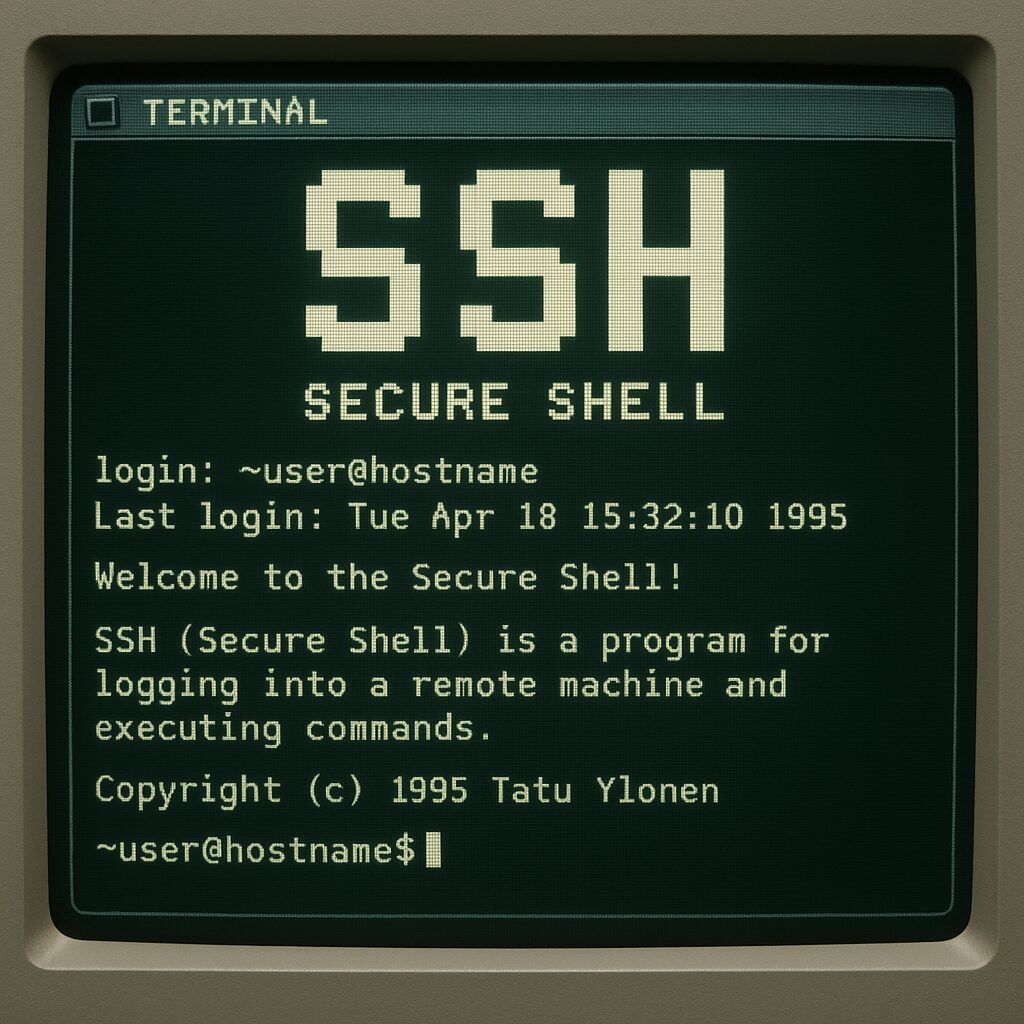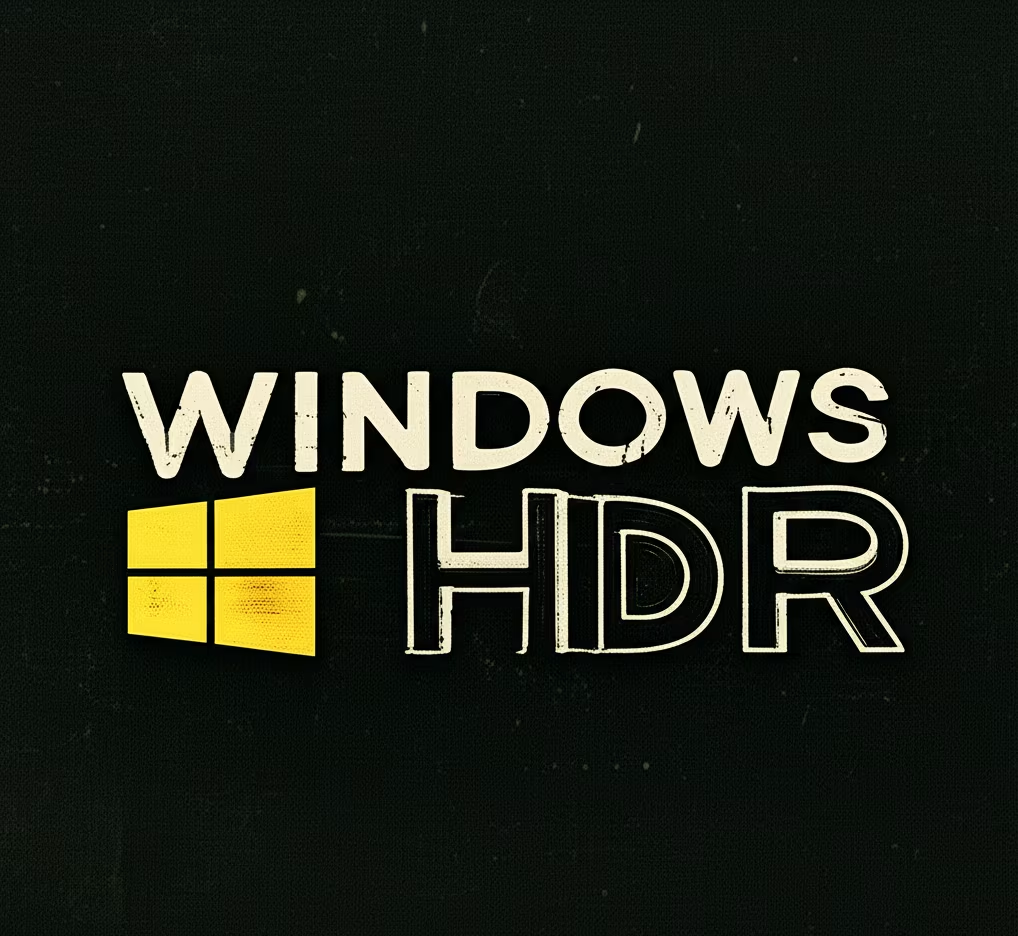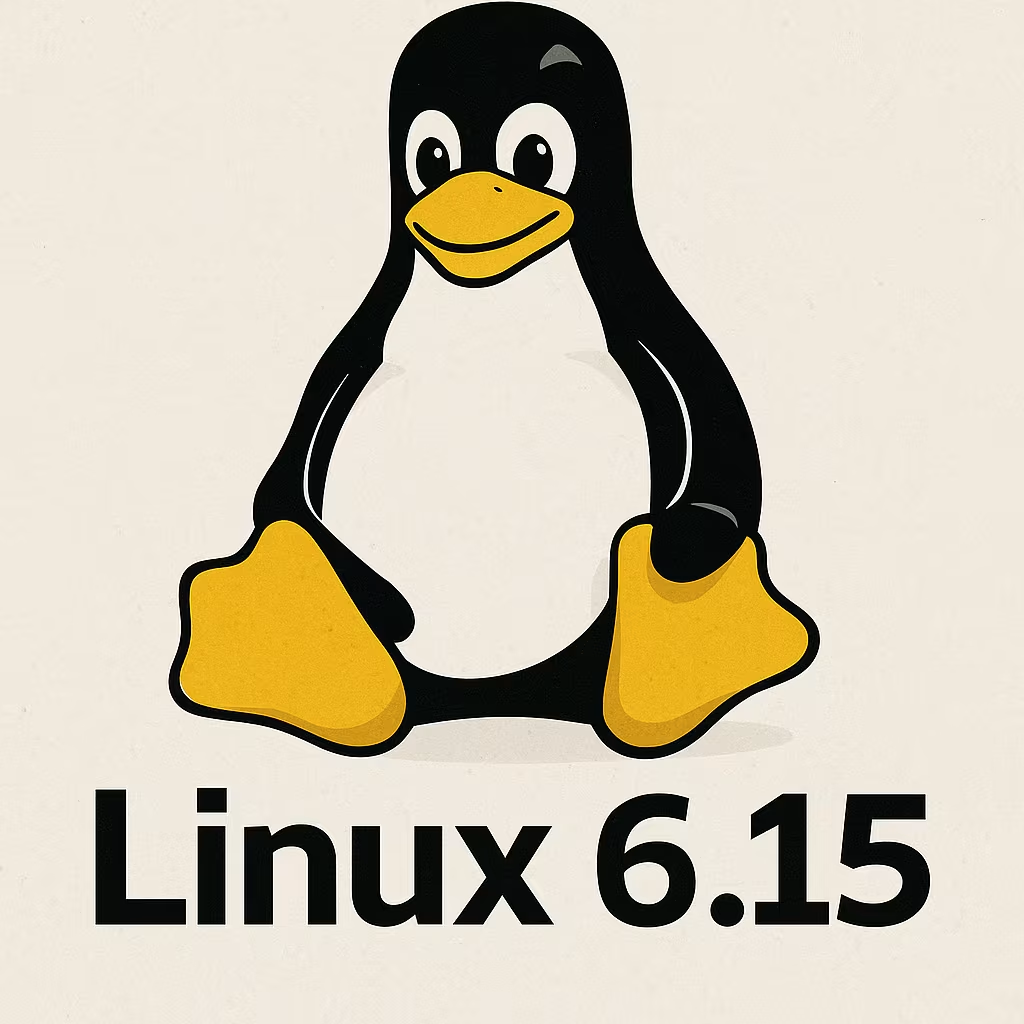
The Story of SSH
The Unseen Backbone of the Digital World
What would the internet look like today if every password, every command, every piece of data sent to a remote server was broadcast in the open for anyone to see? This is not a dystopian hypothetical; it was the reality of the early internet. In an era defined by its academic and collaborative spirit, the foundational protocols for remote access were built on an implicit trust that was shattered when the network exploded into a global, commercial, and often adversarial space. Out of the ashes of this broken trust model, a quiet guardian was born: the Secure Shell protocol, or SSH.
Today, SSH is one of the most critical yet unheralded technologies underpinning the modern digital world. It is the silent, encrypted backbone that enables secure remote administration, automated systems, and the very fabric of cloud computing. It operates unseen, securing billions of connections a day, from a developer pushing code to a repository, to an administrator managing a fleet of cloud servers, to the automated scripts that deploy and maintain the applications we use daily.
This is the story of how a single tool, born of necessity, became the quiet guardian of the internet’s infrastructure.
The Wild West: A Network Built on Trust
To understand the revolutionary impact of SSH, one must first understand the world that necessitated its creation. The early internet of the 1970s through the early 1990s, evolving from ARPANET to NSFNET, was a fundamentally different place. It was a smaller, more insular community of academics, researchers, and government scientists. The networks themselves were often isolated to specific institutions, with physical security over cables, switches, and routers being a reasonable assumption. In this high-trust environment, the design philosophy for network protocols prioritized functionality, interoperability, and convenience over adversarial security. The protocols of this era were not “broken”; they were designed for a world that no longer existed by 1995.
Telnet: Broadcasting Your Secrets
Developed in the late 1960s and formalized in the years following, the Telnet protocol was a cornerstone of early networking. Operating over TCP, typically on port 23, it provided a simple and effective way to establish a text-based, interactive terminal session with a remote computer. For the first time, a user could log in and operate a machine miles away as if they were sitting right in front of it. However, Telnet was a product of its time, designed long before modern cybersecurity was a consideration. Its fatal flaw was its complete lack of encryption. Every keystroke—from the username and password entered at login to the sensitive commands executed and the data returned—was transmitted across the network in plaintext, or “in the clear”.
The r-Commands: Convenience Kills
In the 1980s, the University of California, Berkeley, developed a suite of remote utilities for their Berkeley Software Distribution (BSD) version of Unix. These “r-commands,” most notably rlogin (remote login) and rsh (remote shell), were designed for maximum convenience within a trusted local area network (LAN). They introduced a host-based authentication mechanism using files like /etc/hosts.equiv and user-specific .rhosts files. These files contained lists of trusted hostnames and usernames. If a user from a trusted host connected, they could be granted access without a password.
While incredibly convenient for administrators managing a handful of machines in a secure computer lab, this model was disastrously insecure on a wider, untrusted network. It relied on verifying the source IP address of the connection, but IP spoofing was a relatively simple attack to perform. Furthermore, like Telnet, the r-commands transmitted all session data, including any passwords that were used, completely unencrypted.
The Anatomy of an Insecure Session
The philosophical mismatch of these protocols became a critical vulnerability as the internet grew. The high-trust model was built for a world where the path between client and server was contained within a secured physical perimeter. When connections began traversing the public internet, this assumption was invalidated. A typical internet connection can hop through dozens of independent routers and switches, any one of which could be a point of interception for a “man-in-the-middle” (MITM) or “packet sniffing” attack.
An attacker with access to any of these intermediate network devices could use widely available tools to capture and reconstruct the TCP packets of a Telnet or rlogin session, reading the entire conversation, including credentials, as if it were a plain text file. The simple traceroute command illustrates this peril vividly; running it to any major website reveals a long chain of unknown, untrusted network devices, each a potential weak link and a listening post for an attacker.
This led to a catalog of severe, systemic vulnerabilities for these foundational protocols:
- Lack of Encryption: This was the cardinal sin. The transmission of all data in clear text made them trivially vulnerable to eavesdropping and credential theft.
- Weak Authentication: Telnet’s simple username/password mechanism was susceptible to password guessing and brute-force attacks, in addition to being captured via sniffing. The r-commands’ host-based trust model was fundamentally broken by IP spoofing and was often misconfigured, with a simple
+entry in ahosts.equivfile potentially allowing anyone from any host to log in as any user without a password. - File-Based Authentication Flaws: The
.rhostssystem was a significant risk. Any scenario where an attacker could write to a user’s home directory would allow them to add their own machine to the.rhostsfile and bypass password authentication entirely. Some versions ofrlogineven contained a critical vulnerability where a specially crafted username like-frootcould grant an attacker immediate root access without any authentication. - Vulnerability to Malware: Once an attacker gained access through a compromised Telnet or rlogin session, they had a remote command line on the target system, allowing them to install malware, steal data, or use the compromised machine to launch further attacks.
- Inadequate Logging: These older protocols often had poor logging capabilities, making it incredibly difficult for administrators to perform forensic analysis after a breach to determine who accessed the system and what actions they took.
Ultimately, the core vulnerability of the pre-SSH era was not a simple technical bug but a profound philosophical dissonance. The protocols were functioning exactly as designed, but they were designed for a cooperative, high-trust world that had ceased to exist. The internet’s chaotic and rapid expansion into a global, low-trust network rendered their entire design philosophy obsolete and dangerous. It was clear that remote access needed to be fundamentally re-imagined for an adversarial environment. This set the stage not for a simple improvement, but for a necessary revolution.
A Crisis in Helsinki: The Birth of SSH
The theoretical dangers of the internet’s insecure protocols were well understood within the technical community of the early 1990s. Yet, it often takes a tangible crisis to catalyze a revolution. In 1995, such a crisis occurred at the Helsinki University of Technology in Finland, and in its wake, a young researcher would create the tool that would redefine secure remote access for generations to come.
The Spark of Invention
In 1995, Tatu Ylönen, a researcher at the university, personally witnessed a password-sniffing attack on his institution’s network. Its effect was galvanizing. It transformed the abstract threat of eavesdropping into a concrete reality, making it painfully clear that any password sent over the network was effectively public knowledge. Motivated by the urgent need to secure his own access to the university’s computers from home, Ylönen decided to build a solution.
Despite not being a cryptography expert at the time, he immersed himself in the subject, read a book on cryptography, and in a remarkably short span of about three months, developed the first version of the Secure Shell protocol, SSH-1. His goal was simple and direct: to create a secure replacement for the vulnerable rlogin, Telnet, and rsh protocols that provided strong authentication and guaranteed the confidentiality of the entire session.
An Overnight Sensation
In July 1995, Ylönen released his implementation as freeware with full source code, allowing anyone to use, copy, and inspect it at no cost. The response from the global technical community was immediate and overwhelming. It was as if a dam had broken; system administrators and developers, long aware of the risks they were taking, finally had a viable, easy-to-use solution. The adoption of SSH was explosive. By the end of 1995, a mere five months after its release, it was estimated that SSH had over 20,000 users across fifty countries. By the year 2000, that number had swelled to two million.
This viral growth was a testament to the immense pent-up demand for secure remote access. However, it also created a new problem for Ylönen. He was inundated with support requests, receiving up to 150 emails per day from users and organizations, including large institutions like the University of California, seeking help with implementation. To manage this overwhelming demand and to provide commercial support and continued development, Ylönen founded SSH Communications Security (SCS) on December 31, 1995.
A Port with a Purpose
Even the technical details of SSH’s birth were deliberate. Ylönen contacted the Internet Assigned Numbers Authority (IANA), then overseen by internet pioneers Jon Postel and Joyce K. Reynolds, to request a dedicated TCP port number. He was assigned port 22. The choice was symbolic and strategic: it placed SSH squarely between the port for the insecure File Transfer Protocol (FTP) on port 21 and the port for Telnet on port 23, signaling its intention to replace them.
Furthermore, Ylönen’s decision to release SSH as freeware was not just pragmatic; it was also political. In the mid-1990s, the United States government was actively lobbying to restrict the export and proliferation of strong cryptographic technologies, viewing them as munitions. Ylönen held a contrary view, believing that putting all the power of encryption into the hands of a few governments was a dangerous idea that would inevitably be abused. By releasing SSH with its source code open for all to see, he was making a powerful statement in favor of democratizing security and ensuring that individuals and organizations had the tools to protect their own privacy and communications.
The initial success of SSH was driven by this perfect storm of factors. The problem it solved was clear, present, and acutely felt by its target audience. The solution was elegant, effective, and, crucially, free, removing all barriers to adoption for the universities and individuals who needed it most. The timing was impeccable, coinciding with the internet’s massive public expansion. Finally, its open-source release resonated with the academic and cypherpunk ethos of the time, creating a powerful grassroots movement that established SSH as an unstoppable de facto standard before any government or corporation could stand in its way. The commercial company was not the driver of its success, but a consequence of it.
A Tale of Two Protocols: From SSH-1 to a More Secure Future
The first version of SSH was a brilliant and desperately needed solution, but it was created in haste to solve an immediate crisis. As its popularity soared, the protocol was subjected to intense scrutiny by the global security community, which began to reveal design limitations and potential vulnerabilities in the ad-hoc design of SSH-1. To ensure the long-term security and viability of the protocol, a complete, ground-up redesign was necessary. The transition from the monolithic SSH-1 to the rigorously engineered, layered, and standardized SSH-2 marks the protocol’s maturation from a clever tool into a piece of robust, lasting internet infrastructure.
The Pioneer’s Flaws
SSH-1 was a monolithic protocol, meaning its various functions—transport, authentication, and connection management—were all intertwined in a single, complex block of logic. It was also documented after it was written, with its IETF Internet-Draft essentially describing the behavior of the existing software rather than specifying a design to be implemented. This architecture made it difficult to analyze and even harder to extend without risking the introduction of new flaws.
Specific vulnerabilities and weaknesses were identified in the SSH-1 protocol:
- It used a weak 32-bit Cyclic Redundancy Check (CRC-32) to verify the integrity of transmitted data. While a CRC can detect accidental corruption, it provides no cryptographic protection against a deliberate attacker, and a known insertion attack could exploit this weakness to inject malicious data into an encrypted stream.
- It lacked true forward secrecy. The session’s encryption key was itself encrypted with the server’s long-term host key. This meant that if an attacker could compromise the server’s host key at a later date, they could potentially decrypt previously recorded SSH-1 sessions.
- Due to these and other issues, SSH-1 is now considered obsolete and dangerously insecure, and its use is strongly discouraged.
Building a Better Standard: The Birth of SSH-2
Recognizing that these issues could not be fixed without breaking backward compatibility, SSH Communications Security introduced a new, incompatible protocol design in 1996, which would become SSH-2. To ensure this new version was robust and developed in the public interest, the Internet Engineering Task Force (IETF) formed a dedicated working group named “secsh” (for Secure Shell) to formalize the protocol. This collaborative, standards-driven process culminated in 2006 with the publication of a series of Requests for Comments (RFCs), primarily RFCs 4250 through 4256, which officially defined SSH-2 as an internet standard.
The most profound change in SSH-2 was the move from a monolithic design to a clean, layered architecture:
- The Transport Layer (SSH-TRANS): The lowest level, responsible for establishing a secure connection. It handles the initial key exchange, server authentication, and setting up the encryption, compression, and integrity verification for all subsequent data.
- The User Authentication Layer (SSH-AUTH): Runs on top of the transport layer and is responsible for authenticating the client user to the server using one or more authentication methods.
- The Connection Protocol (SSH-CONN): The highest level, which defines the concept of “channels.” These channels are multiplexed over the single underlying secure connection, allowing for multiple concurrent sessions (e.g., several shell sessions, file transfers, and port forwardings) to run simultaneously.
Why SSH-2 Was a Game-Changer
This new architecture enabled a host of critical security and functionality improvements that made SSH-2 vastly superior to its predecessor. The following table provides a direct comparison of the two protocols, highlighting the security implications of each major change.
| Feature | SSH-1 (Legacy) | SSH-2 (Modern Standard) | Security Implication |
| Architecture | Monolithic protocol | Layered: Transport (TRANS), Auth (AUTH), Connection (CONN) | Improved Security & Extensibility: Layering separates concerns, making the protocol easier to analyze for vulnerabilities and extend with new features without affecting the core. |
| Integrity Check | Weak 32-bit CRC | Strong, negotiated HMACs (e.g., HMAC-SHA1, HMAC-SHA256) | Protection Against Tampering: HMACs cryptographically prevent data modification in transit. CRC-32 was vulnerable to insertion attacks. |
| Key Exchange | Server’s host key encrypts the session key | Diffie-Hellman (DH) key exchange | Perfect Forward Secrecy (PFS): Compromise of the server’s long-term key does NOT compromise past session data. Each session has a unique, ephemeral key. This is a massive security gain. |
| Algorithm Negotiation | Only the bulk cipher was negotiable | All crypto primitives are negotiable (ciphers, MACs, key exchange, compression) | Crypto-Agility: The protocol can adapt over time, phasing out weak algorithms (like 3DES, SHA-1) and adopting new, stronger ones (like AES-GCM, ChaCha20, Ed25519) without a full protocol rewrite. |
| Session Management | One shell session per connection | Multiple channels (sessions, forwards) over one connection | Efficiency & Flexibility: Reduces overhead by multiplexing many logical streams over a single secure TCP connection. |
| Session Rekeying | Not supported; same key for entire session | Supported and recommended (e.g., every 1GB or 1 hour) | Limits Damage: Limits the amount of data that can be decrypted if a single session key is ever compromised. |
| Authentication | Fixed sequence of methods (e.g., Rhosts, RSA, Password) | Flexible, server-driven authentication flow | Enhanced Security Control: The server can demand multiple authentication methods (e.g., key + password) and control the process, strengthening access control. |
The development of SSH-2 exemplifies a critical maturation process in the world of internet protocols. It represents the deliberate move away from a single-author, “it works for me” solution toward a collaborative, standardized, and rigorously engineered framework. The principles introduced in SSH-2—layering, algorithm agility, and perfect forward secrecy—were not just features; they were architectural tenets designed to ensure the protocol’s longevity and security in the face of unknown future threats. This transition reflects a broader and essential trend in the development of critical internet infrastructure: the evolution from ad-hoc solutions to formal, community-vetted standards, a process in which SSH was a true pioneer for security protocols.
The Fork in the Road: How OpenSSH Became the Standard
As the official SSH-2 protocol was being standardized, a parallel drama was unfolding that would prove just as consequential for the future of Secure Shell. The original spirit of SSH—a free and open tool for the entire community—began to clash with the commercial realities of the company that now stewarded it. As the official implementation became more proprietary, the open-source community, which had been instrumental in its initial success, responded by initiating a fork. This act not only preserved free access to a critical security tool but also led to the creation of OpenSSH, which would become the most scrutinized, widely deployed, and trusted SSH implementation in the world.
A Clash of Ideals
After its initial freeware release, the SSH software developed by Tatu Ylönen’s company, SSH Communications Security (SCS), began to move towards a more restrictive, commercial licensing model. While the original SSH-1 had used some free software components like GNU libgmp, later versions from SCS became increasingly proprietary. The licenses for these new versions placed restrictions on commercial use, forcing companies to purchase expensive licenses. Some licenses even forbade the creation of versions for certain operating systems, such as Windows and DOS. This created a significant dilemma for the burgeoning internet community. The world was rapidly standardizing on SSH for security, but the “official” version was no longer fully open or free for all uses.
The Community Fights Back
This situation was untenable for many developers, universities, and organizations that had built their infrastructure around SSH and believed that such fundamental security software should remain open and auditable by all. The solution lay in the history of the software itself. The last version of Ylönen’s original code that had been released under a permissive, BSD-style open-source license was version 1.2.12. This specific version became the foundational code base for a new, community-driven effort to create a truly free SSH.
The first step was a project called OSSH, started in early 1999 by Swedish developer Björn Grönvall, who rediscovered the 1.2.12 source code and began fixing bugs. However, OSSH only ever supported the older SSH-1.3 protocol and its development eventually faded as a more ambitious project took flight.
Enter OpenBSD: Forging a Free Alternative
In late 1999, developers from the OpenBSD project took notice. OpenBSD, an operating system renowned for its fanatical, proactive focus on security and correct code, was a natural home for such an effort. A team of developers, including prominent figures like Theo de Raadt, Niels Provos, and Markus Friedl, decided to fork the OSSH code and create their own definitive, free SSH implementation in time for the OpenBSD 2.6 release.
The development of OpenSSH was rapid and intense, driven by a clear, security-first philosophy. The team’s work involved several key efforts:
- Aggressive Code Cleanup: The first priority was to simplify the source code. Theo de Raadt led the effort to remove non-portable and unnecessarily complex code, operating on the principle that simpler code is easier to audit and secure.
- Removing Encumbered Code: Niels Provos undertook the critical task of stripping out all proprietary and patent-encumbered components. This meant removing dependencies on GPL-licensed libraries and, most notably, working around the patent on the RSA algorithm, which had not yet expired in the United States at the time. This was achieved by replacing internal cryptographic functions with calls to the external OpenSSL library.
- Modern Protocol Support: While the fork began with SSH-1 code, Markus Friedl was instrumental in rapidly modernizing it. He first implemented the more compatible SSH-1.5 protocol and, crucially, later added full support for the superior SSH-2 protocol. This ensured that OpenSSH was not a legacy project but a viable, modern alternative to the commercial offerings.
The Rise of OpenSSH
OpenSSH was officially released as part of OpenBSD 2.6 on December 1, 1999. Almost immediately, a separate “portability team” was formed to adapt the code to run on other operating systems, including Linux, Solaris, AIX, and Mac OS X. This effort was wildly successful. By 2005, OpenSSH was already the single most popular SSH implementation. Today, it is the de facto standard, included by default in virtually every Unix-like operating system and many network appliances. In a sign of its complete victory, OpenSSH officially removed all support for the insecure SSH-1 protocol in its 7.6 release.
The story of OpenSSH is a classic case study in the power of the open-source ethos. It demonstrates that when a piece of essential infrastructure becomes restricted, the community will often route around the restriction to create a free and open alternative. In this case, the alternative, forged in the security-focused crucible of the OpenBSD project, ultimately surpassed the original in quality, trust, and adoption. This success was not accidental. It was a direct result of a development philosophy that prioritized code simplicity, correctness, and public auditability above all else. This disciplined, security-first approach built a foundation of trust that became OpenSSH’s most valuable asset, ensuring its place as the world’s premier SSH implementation.
More Than a Shell: The Powerful SSH Ecosystem
The Secure Shell protocol is named for its most obvious function: providing a secure interactive command-line shell. However, its true power and enduring legacy lie in the capabilities built upon its secure foundation. The robust, layered architecture of the SSH-2 protocol provided a generic and extensible platform for securing a wide range of network communications. It transformed SSH from a simple replacement for Telnet into a secure transport layer upon which a whole ecosystem of tools could be built, enabling new networking paradigms and replacing other insecure protocols along the way. Two of the most significant extensions in this ecosystem are the SSH File Transfer Protocol (SFTP) and the versatile mechanism of SSH Tunneling, or Port Forwarding.
SFTP: Secure File Transfers Done Right
For decades, the standard for transferring files across the internet was the File Transfer Protocol (FTP). Like Telnet, FTP was a product of a more trusting era and suffered from the same core flaw: it transmitted credentials and data over unencrypted channels. An early attempt to secure file transfers was the Secure Copy Protocol (SCP), which ran over an SSH connection. While secure, SCP was very basic, essentially providing only the ability to copy files from one place to another. It lacked modern features like the ability to resume an interrupted transfer, list the contents of a remote directory, or perform other remote file management tasks.
To address these shortcomings, the IETF designed the SSH File Transfer Protocol (SFTP) as an extension of the SSH-2 protocol. SFTP is not just a file transfer protocol; it is a complete file access and management protocol that operates as a “subsystem” within an already established SSH session. This means it uses the same single port (22) and the same robust authentication mechanisms (passwords or public keys) as the parent SSH connection, making it vastly simpler to configure and secure than its competitors.
Unlike the rudimentary SCP, SFTP provides a rich set of operations, including directory listings, remote file creation and deletion, permission changes, and resuming interrupted transfers, making it behave more like a remote file system. This functionality also makes it superior to FTPS (FTP over SSL/TLS). While FTPS adds encryption to the legacy FTP protocol, it inherits FTP’s complexity, requiring multiple ports for control and data channels and notoriously difficult firewall configurations. SFTP’s single-port design makes it far more reliable and easier to manage in modern network environments.
The Magic of SSH Tunneling (A Double-Edged Sword)
Perhaps the most powerful and flexible feature built on the SSH-2 platform is port forwarding, commonly known as SSH tunneling. This mechanism allows a user to transport arbitrary TCP/IP traffic through an encrypted SSH connection, effectively creating a secure “pipe” or “tunnel” from one network point to another. This capability has both powerful legitimate uses and significant security risks. There are three primary types of SSH tunneling.
Local Port Forwarding: Accessing Internal Resources
Configured with the -L option in the OpenSSH client, local port forwarding is used to access a service on a remote network as if it were local. The SSH client listens on a port on the user’s local machine. When an application connects to this local port, the SSH client intercepts the connection and forwards it through the encrypted tunnel to the SSH server. The SSH server then makes a connection to the final destination server on its network.
The canonical use case is for a developer or administrator to securely access an internal resource, like a database or web application, that is not exposed to the public internet. For example, a developer at home can SSH into a corporate “bastion host” or “jump server” and forward their local port 3306 to the internal database server’s port 3306. They can then point their local database client to localhost:3306, and all communication will be securely tunneled to the internal database. This technique is also widely used to wrap legacy applications that lack native encryption in a secure layer.
Remote Port Forwarding: The Reverse Tunnel
Remote port forwarding, or “reverse tunneling,” configured with the -R option, does the opposite. It allows a service running on a local machine (behind a firewall) to be exposed to the world via a remote server. A legitimate use case would be a developer wanting to demonstrate a web application running on their laptop to a client. They could SSH into a publicly accessible server and forward a port on that public server (e.g., 8080) back to their local machine’s web server port. The client could then access the public server on port 8080 to view the application.
However, this is also the mechanism for creating a malicious backdoor. An attacker who gains even temporary access inside a corporate network can use remote forwarding to establish a persistent point of entry. By initiating an SSH connection outbound from a compromised internal machine to a server they control on the internet, they can forward a port on their server back to a shell on the internal machine. This connection bypasses most inbound firewall rules, as it was initiated from the trusted inside of the network, creating a hidden and persistent backdoor.
Dynamic Port Forwarding: Your Personal SOCKS Proxy
Configured with the -D option, dynamic port forwarding creates a SOCKS proxy on the local machine. Instead of forwarding a single, pre-defined port, it creates a general-purpose tunnel. Any application on the local machine that is configured to use this SOCKS proxy will have all of its network traffic automatically routed through the encrypted SSH connection to the remote server, from which it will then emerge onto the internet. This is commonly used for general-purpose secure web browsing, bypassing network filtering, or masking one’s location.
The existence of this rich ecosystem is a direct consequence of the superior, layered design of the SSH-2 protocol. The Connection Protocol (SSH-CONN), with its ability to multiplex many logical channels over a single secure connection, is the direct technical enabler for both SFTP (which runs as a channel subsystem) and the various forms of port forwarding (which each open their own channels). This architectural foresight transformed SSH from a simple remote shell into a generic secure transport platform, which is a key reason for its profound and enduring relevance.
The Legacy and Future of a Digital Guardian
Nearly three decades after a single password-sniffing incident sparked its creation, the Secure Shell protocol is more deeply embedded in the fabric of our digital infrastructure than ever before. It has evolved from a simple security tool into the foundational protocol for the automated, distributed, and cloud-native world. Its legacy is one of silent, indispensable guardianship. However, this very success has created new and complex challenges in management and security, and the protocol must now continue to evolve to face the looming threat of a quantum future.
The Unseen Engine of the Cloud and DevOps
Modern cloud computing as we know it is managed by SSH. When a developer or an automated system provisions a new Linux virtual machine—whether an EC2 instance in Amazon Web Services, a VM in Google Cloud, or a droplet in DigitalOcean—SSH is the default, and often the only, method for administrative access. Cloud providers have built sophisticated platforms around SSH, integrating key management directly into their Identity and Access Management (IAM) systems. They can automatically generate and distribute key pairs, associate public keys with user accounts, and even issue short-lived, certificate-based credentials for temporary access.
This seamless integration makes SSH the essential engine of modern DevOps practices.
- Automation and Configuration Management: The entire paradigm of “Infrastructure as Code” relies on SSH. Tools like Ansible, Chef, and Puppet use SSH as their primary transport layer to securely connect to thousands of servers, apply configurations, install software, and ensure a desired state, all without human intervention.
- Continuous Integration/Continuous Deployment (CI/CD): Automated CI/CD pipelines, the heart of rapid software delivery, use SSH at nearly every stage. A tool like Jenkins or GitLab CI will use an SSH key to securely clone source code from a repository, then use SSH again to connect to staging or production servers to deploy the new application, run tests, and transfer artifacts.
- Secure Version Control: The world’s dominant version control system, Git, relies heavily on SSH as a transport protocol. When developers use an SSH URL (e.g.,
git@github.com:user/repo.git), they are leveraging SSH’s powerful public-key authentication to securely push and pull changes. This is generally considered more secure and is often more convenient for developers than managing HTTPS personal access tokens. Recent versions of Git even allow developers to cryptographically sign their commits and tags using their SSH key, providing a strong guarantee of authorship.
The New Challenge: SSH Key Sprawl
The greatest strength of SSH keys—the ease with which any user can generate them—has become their greatest weakness at an enterprise scale. This has led to a massive and dangerous management problem known as “SSH key sprawl”. In large organizations, there can be millions of SSH keys distributed across servers, laptops, and automated systems. Many of these keys grant highly privileged or even root access.
Over time, these keys are often forgotten, never rotated, and left active long after the employee or system they were issued for is gone. A recent audit of one major financial institution found that a staggering 90 percent of the SSH keys that had access to its data were not being actively used but were still valid credentials. Each of these unmanaged, unmonitored keys represents a permanent, static credential and a potential attack vector. This is widely considered the single biggest practical security challenge for SSH in the modern enterprise.
The Future: Zero Trust and Quantum-Proofing SSH
The industry is now working to address these challenges, pushing SSH into its next evolutionary phase. This evolution is happening on two main fronts:
- Keyless and Certificate-Based Access: To combat key sprawl, the security paradigm is shifting towards a “Zero Trust” model. Instead of relying on long-lived, static SSH keys that represent implicit trust, modern systems are moving towards ephemeral, certificate-based access. In this model, a central Privileged Access Management (PAM) system acts as a certificate authority. When a user or service needs access, they authenticate to the PAM, which then issues a short-lived SSH certificate valid only for that specific user, for that specific server, for a brief period of time. The certificate automatically expires, leaving no permanent credential to be stolen or mismanaged. This just-in-time access model eliminates the problem of key sprawl and is a much better fit for the dynamic, on-demand nature of cloud environments.
- Quantum-Resistant Cryptography: A more distant but potentially more catastrophic threat is the advent of cryptographically relevant quantum computers. Such machines would be capable of breaking the public-key algorithms (like RSA, ECDSA) that currently secure SSH key exchange and authentication. To prepare for this, the cryptographic community is developing Post-Quantum Cryptography (PQC) algorithms. SSH implementations, most notably OpenSSH, are already actively experimenting with and integrating these new quantum-resistant algorithms (such as NTRU Prime) to ensure that communications secured today will remain confidential in a post-quantum world.
This evolution demonstrates a fascinating and recurring cycle in technology. A powerful, decentralized tool like SSH enables a technological revolution (the cloud and DevOps). The widespread, uncontrolled use of that tool then creates a new, centralized problem (key management). This new problem, in turn, drives the development of the next generation of centralized, policy-driven solutions that build upon, and in some ways replace, the original tool.
The Quiet Guardian Endures
The history of the Secure Shell protocol is a remarkable journey from a single researcher’s pragmatic response to a local security breach to its current status as an indispensable global standard. Forged in the open-source community and hardened by decades of rigorous peer review and real-world adversarial pressure, SSH stands as a testament to the power of collaborative engineering. It began by solving the glaring and fundamental problem of insecure remote administration, replacing the dangerously naive protocols of a bygone era.
From these humble origins, it evolved. The move from the ad-hoc SSH-1 to the formally standardized, layered architecture of SSH-2 was not merely an upgrade but a transformation. It turned a simple tool into a robust platform, enabling a rich ecosystem of secure services like SFTP and the powerful flexibility of SSH tunneling. This foresight laid the groundwork for its seamless adoption as the lingua franca of automation, the engine of DevOps, and the administrative backbone of the cloud.
Today, SSH is woven so deeply into the fabric of our digital world that it is largely invisible, operating silently to secure billions of critical connections every day. While the challenges it faces continue to evolve—from the organizational chaos of key sprawl to the existential threat of quantum computing—the protocol itself was designed to adapt. The principles of strong, accessible, and crypto-agile security embodied by SSH ensure that its legacy as the internet’s quiet guardian will endure for decades to come.





